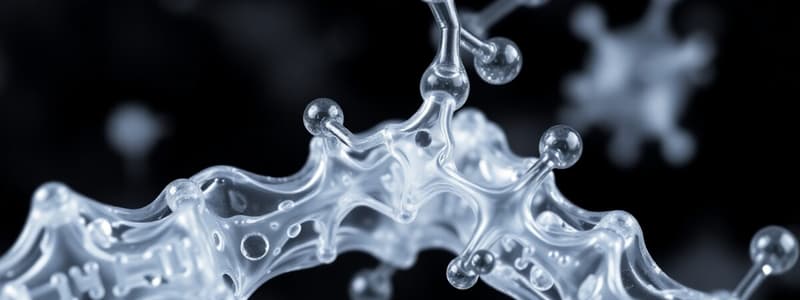Podcast
Questions and Answers
An enzyme is tested using the King-Armstrong method and found to be elevated in a patient. Which condition is most likely indicated by this result?
An enzyme is tested using the King-Armstrong method and found to be elevated in a patient. Which condition is most likely indicated by this result?
- Acute Myocardial Infarction
- Paget’s Disease (correct)
- Prostate Cancer
- Viral Hepatitis
Which of the following statements correctly describes the relationship between an apoenzyme and a holoenzyme?
Which of the following statements correctly describes the relationship between an apoenzyme and a holoenzyme?
- Apoenzyme is the complete, active enzyme, while holoenzyme is the protein portion without the cofactor.
- Apoenzyme requires a metal ion for activation, while holoenzyme requires a coenzyme.
- Apoenzyme and holoenzyme are isoenzymes that catalyze different reactions.
- Apoenzyme is the protein portion of an enzyme without the cofactor, while holoenzyme is the complete, active enzyme. (correct)
Which enzyme is most specific to liver damage?
Which enzyme is most specific to liver damage?
- AST
- LDH
- CK-MB
- ALT (correct)
Following an acute myocardial infarction (AMI), which cardiac marker would be the last to return to baseline levels?
Following an acute myocardial infarction (AMI), which cardiac marker would be the last to return to baseline levels?
In a clinical context, which of the following enzymes utilizes alanine $\alpha$-keto as a substrate in its corresponding method?
In a clinical context, which of the following enzymes utilizes alanine $\alpha$-keto as a substrate in its corresponding method?
Which enzyme activity is unaffected by tartrate?
Which enzyme activity is unaffected by tartrate?
What circumstance would cause a false decrease in Alkaline Phosphatase (ALP) levels?
What circumstance would cause a false decrease in Alkaline Phosphatase (ALP) levels?
After a myocardial infarction, when do Lactate Dehydrogenase (LDH) levels typically peak?
After a myocardial infarction, when do Lactate Dehydrogenase (LDH) levels typically peak?
Which of the following markers of acute myocardial infarction rises earliest?
Which of the following markers of acute myocardial infarction rises earliest?
What is the typical reference range for Prostate-Specific Antigen (PSA) in ng/mL?
What is the typical reference range for Prostate-Specific Antigen (PSA) in ng/mL?
Flashcards
Apoenzyme
Apoenzyme
The protein portion of an enzyme, without its cofactor.
Holoenzyme
Holoenzyme
A complete, active enzyme, including both the protein (apoenzyme) and any necessary cofactors.
Active Site
Active Site
The specific region of an enzyme where the substrate binds and the catalytic reaction occurs.
Allosteric Site
Allosteric Site
Signup and view all the flashcards
Isoenzyme
Isoenzyme
Signup and view all the flashcards
Catalyzes reaction
Catalyzes reaction
Signup and view all the flashcards
PSA
PSA
Signup and view all the flashcards
Myoglobin: Onset (hours)
Myoglobin: Onset (hours)
Signup and view all the flashcards
Troponin I: Onset (hours)
Troponin I: Onset (hours)
Signup and view all the flashcards
CK-MB: Onset (hours)
CK-MB: Onset (hours)
Signup and view all the flashcards
Study Notes
- Enzymes catalyze reactions
Definition of Terms
- Apoenzyme: the protein part of an enzyme, needs a cofactor to work.
- Holoenzyme: the complete, active enzyme.
- Active site: place where the enzyme's reaction occurs.
- Allosteric site: a site different from the active site.
- Isoenzymes: different forms of an enzyme, catalyze the same reaction.
Enzyme categories:
- Oxidoreductase: performs oxidation/reduction reactions, examples include LDH, G6PD, and Malate dehydrogenase
- Transferase: moves groups from one substrate to another, such as AST, ALT, CK, and GGT
- Hydrolase: causes hydrolysis, examples include ACP, ALP, 5'NT, AMS, LPS, and CHS
- Lyase: removes groups without hydrolysis, such as Aldolase
- Isomerase: interconverts isomers
- Ligase: joins two substrate molecules, includes synthases
Hepatic Enzyme Profile
- ALP (Alkaline Phosphatase): liver, kidney, bone, placenta, intestine, and WBC sources uses B-glyceroPO4 and p-nitrophenylPO4 substrates, Bodansky, Shenowara Jones, King-Armstrong, or Bessy Lowry-Brock methods resulting in a pH of 10 that is greatly elevated in Paget's disease, avoid using EDTA-Citrate-Oxalate
- ALT (SGPT): Liver and RBC sources using Alanine a-keto substrate and Reitman-Frankel (DNPH) methods resulting in a liver-specific marker with marked elevation with viral hepatitis, De ritis ratio: >1 = viral; <1 = non-viral
- LD (Lactate Dehydrogenase: all tissues sources using Wacker's method (forward) or Wrobleuski La Due (reverse) or Wrobleuski Cabaud Berger Broida methods resuting in a NAD+ (cofactor), LD4 and LD5 enzyme that can be stored at 25°C for up to 24 hours
- GGT (Gamma-Glutamyl Transferase): Canaliculi of hepatic cells, Kidney, Prostate, and Pancreas sources using Gammaglutamyl p-nitroanilide substrate and SZAZ methods resulting in a marker that is most sensitive for alcoholic hepatitis
- ChE (Cholinesterase): Pseudo- Liver sources using Acetylcholine and Pseudo- Michael; Ellman methods, ChE: CNS, RBC, Lungs, Spleen, Pseudo: Liver, Succinylcholine (relaxant)
Cardiac Enzyme Profile
- CK (Creatine Kinase): Cardiac, skeletal, and brain tissues sources using Tanzer-Gilvarg (forward) or Oliver-Rosalki (reverse) methods for identifying anesthetic poisoning, CK-BB (fastest migrating; most anodal), CK-MB, CK-MM (slowest; least anodal)
- AST (SGOT): comes from the Liver, heart, skeletal muscle, the source uses Aspartate a-keto substrate and Karmen Method (Ph 7.5; 340 nm) methods that is sensitive indicator of AMI & Duchenne disorder
- LD is from All tissues sources using Wacker method (forward) - pH 8.8 or Wrobleuski La Due (reverse) - pH 7.2 or Wrobleuski Cabaud Berger Broida methods using LD1 (anodic & heat stable) used to check the LD2 (heat stable & major isoenzyme in the sera of healthy persons) of the LD5 when checking for LD5 (cathodic & cold labile), Flipped ratio: LD1>LD2
- Myoglobin: Responsible for O2 supply of striated muscle
- Troponin: 3 subunits I (inhibitory), T (tropomyosin-binding) & C (calcium-binding)
Acute Pancreatitis Profile
- AMS: Salivary glands, Pancreas sources using Saccharogenic or lodometric/Amyloclastic Chromogenic or Kinetic methods to check Pancreatic AMS: diastase, Salivary AMS: ptyalin or check for MicroAMS: unbound (free), MacroAMS: bound to IgG and IgA, test identifies for Earliest pancreatic marker with its Smallest enzyme in size to check Salivary AMS: inhibited by wheat germ lectin
- LPS: Pancreas sources uses Olive Oil/Triolein (pure form of TAG) in Cherry-Crandall or Sigma-Tietz Titration methods to end up with the End product of Fatty Acids identified by its Most specific pancreatic marker
Prostatic Cancer Profile
- ACP (Acid Phosphatase): RBC and Prostate sources using Chemical Inhibition Test and Organophosphates through RBC-ACP: inactivated by Cu++, unaffected by Tartrate or through P-ACP: unaffected by Cu++, inactivated by Tartrate methods being Very labile (add 5M acetate buffer/citrate tablet to preserve)
- PSA (Prostate Specific Antigen): sample using Tartrate methods, is Most useful for tumor marker for prostate cancer with a Reference Range: of 0-4ng/mL
Acute Myocardial Infarction Markers:
- Myoglobin: onset at 1-3 hours, peaks at 5-12 hours, lasts 18-30 hours
- Troponin I: onset at 3-4 hours, peaks at 10-24 hours, lasts 7 days up to 10-14 days
- Troponin T: onset at 3-6 hours, peaks at 12-18 hours, lasts 5-10 days
- CK-MB: onset at 4-6 hours, peaks at 12-24 hours, lasts 48-72 hours
- AST: onset at 6-8 hours, peaks at 24 hours, lasts 5 days
- LDH: onset at 12-24 hours, peaks at 48-72 hours, lasts 10-14 days
Studying That Suits You
Use AI to generate personalized quizzes and flashcards to suit your learning preferences.





